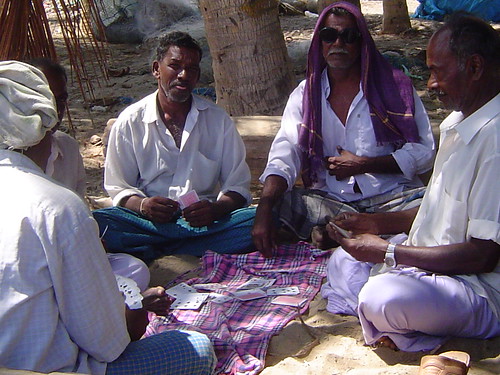
On the first day of February 2005, I found myself standing in a palm
grove drinking juice straight from a green coconut on an island off
the southern coast of India. Sounds idyllic, even sybaritic. Walking
around the little island of Sottikuppam, 250 km south of Chennai, it's
easy to miss the telltale signs of tsunami devastation, and only see
the beauty here. After disembarking from a small ferry, one walks the
sandy lanes lined with blue and lemon pastel houses past the pink and
green fishing nets drying in the sun, hearing laughter flow out of
school windows, and seeing fisherman sit in the shade playing cards.
However, if you continue walking the short distance to the beachfront
on the eastern side of the island, you'll find wreaked fiberglass
fishing boats, gaping holes in their sides, and long spindles of wood
that used to form a catamaran, useless now. There are fishing nets
bundled together at the base of coconut trees, too torn to be of any
good for catching fish, and on the southern end of the island, there
is a gigantic beached oil ship unmoored from a harbor near
Cuddalore—all a result of the violent and unruly tsunami that struck
on December 26.
This is my second visit to Sottikuppam in two weeks. I've come back
to this place after visiting several other tsunami affected areas in
Tamil Nadu and Kerala. The people and the stories in Sottikuppam kept
coming back to me on my travels—I needed to come back to them to see
how they were faring. Consider me a concerned citizen of the world. I
am not a reporter or a government official, not the leader of a
prestigious aid organization. I am a lover of India and its people,
and due to a fundraiser I held before I came here, I have a small sum
of money that I would like to give to tsunami victims that need aid.
Sottikuppam interested me from the beginning. Since it is an island,
its people are both protected and isolated from mainland issues. This
can have positive and negative effects. For example, in several
places I visited, there were rampant tales of corruption: fisherboat
owners keeping aid for themselves, instead of disseminating it to
laborers that run the boat; a social welfare officer taking money
meant for orphans.
On the contrary, Sottikuppam is devoid of any air of corruption. From
my first talk with the village chief, V. Raman, and the elders, there
was a sense of community, a gracious attitude, and a general feeling
of goodwill. It seems that being an island, a contained community,
has made them wholesome and dependent on one another; unfortunately,
it has also kept them from receiving aid quickly and effectively.
This island of 1,780 lost twenty-five people in the tsunami,
twenty-three of which were children. Any loss of life is a tragedy,
but admittedly, Sottikuppam didn't lose as many people as Cuddalore or
Nagipattinam. For this reason, it seems, the island hasn't made
headlines. But their needs are just as sharply felt as other fisher
communities. When rice intended for them is taken by selfish
mainlanders, the 400 surviving children on Sottikuppam go hungry.
When the Collector appears and exhorts fisherfolk to go back to sea,
the fisherfolk can only count on each other when a boat is overturned
and a man is sent to the hospital. When sacks of government-given aid
are opened to reveal kilos upon kilos of yellow, soiled rice, the
elders have to find another way for their people to eat. When
villagers hear of government grants and additional aid, they are the
ones left waiting with nothing to show when those promises never
materialize.
The first time I visited the island people, their situation was dire.
More than three weeks had passed since the tsunami hit, and they had
only received standard government aid. Other areas were besieged by
help from Unicef and other big name organizations. Sottikuppam had
been overlooked by private donors and NGOs and as a result, they were
struggling.
My most recent visit was more encouraging. Members of Development of
Humane Action (DHAN), an organization based in Madurai, have adopted
Sottikuppam and committed themselves to repairing all boat engines and
damaged boats here. This move alleviates some worry and financial
strain, as some of the boats will cost upwards of Rs. 20,000 to
repair. Other organizations have given good quality rice, cooking
utensils, bed sheets and saris. All supplies offered are divided
equally amongst the two thousand villagers, which means that 750 kilos
of rice will only last one day.
For now, life is still being lived day to day. A cooking fire burns
continuously at the small school, where communal meals are served.
Fishermen bide their time under palms, waiting for the chance to
resume their diurnal routine. Village leaders meet regularly to
discuss ways to get back on their feet. The situation is tense, but
the pace here is slow and relaxed. The government has given as much
as they can. One or two organizations have stepped up to help. But,
how many other villages are suffering in silence? How many other
fisher-families must wait for their boats to be made sea-worthy? How
many people are dependent upon the kindness of strangers?
No comments:
Post a Comment
It is always great to hear from site visitors, whether your comments are positive or negative. Thanks for sharing your perspective.